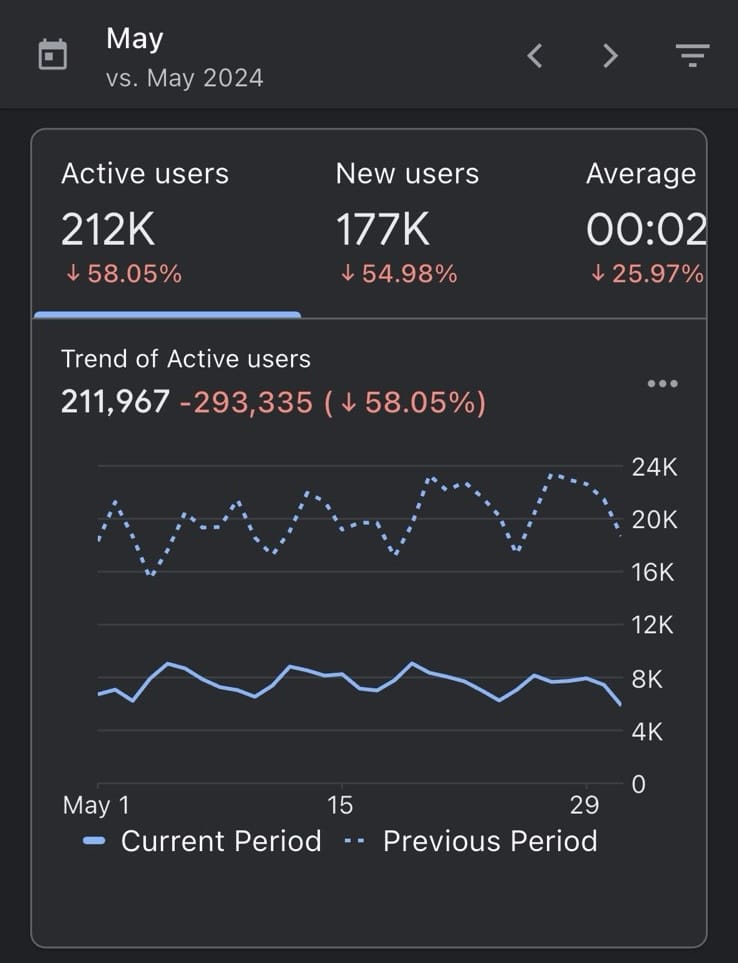Organic Traffic Devastated: Zero-Click Search and the Open Web Consumed by AI. Is There a Bright Future for Ad-Supported Websites?

Let’s be honest: the internet you knew two years ago is already gone.
Search as we knew it, typing a query into Google, skimming a list of blue links, clicking around, is being replaced by something faster, smarter, and radically more efficient. Thanks to AI, users are skipping the scroll and getting straight to the answer.
So what does that mean for content creators, publishers, SEO professionals, and marketers?
Here’s what’s changing, what still works, and how to adjust your.. well, not search, but overall business strategy now, before 2026 makes you obsolete.
1. Organic Search Traffic Is Dropping. Fast
😭 We’ve all seen it: organic traffic from search is down. Dramatically.

Since 2024, many publishers, especially in healthcare, finance, and how-to content, have watched their traffic shrink. Not because their content got worse, but because AI is answering queries directly in search results. Google’s AI Overviews, OpenAI’s ChatGPT, and Gemini are doing the work before users ever visit your page.
2. Blue Links Still Exist. But They’re No Longer the Goal
Traditional search isn’t gone, but it’s no longer the primary way people discover information. Users are becoming used to AI-first experiences. Fast, summarized, and interactive.
It’s not unlike when iPhone disrupted Nokia. The interface changed. The expectations changed. But unlike Nokia, Google is adapting fast, embedding Gemini across Android and Search to stay relevant.
There’s still an audience for classic Google search. But it’s shrinking, especially among younger users who want instant answers, not a list of 10 links.
3. Who’s Losing the Most Right Now
Here’s who's feeling the squeeze:
- Niche publishers built around SEO traffic
- Affiliate sites
- Agencies relying on link-building tactics
- Bloggers in saturated advice categories, how to guides, manuals etc.
So, what's the fix? You need to shift from playing the Google game to owning your user experience and monetization strategy.
My unpopular view: News & Magazine content in general is NOT at risk
A huge portion of internet traffic still goes to news and magazine-style content.
Remember when you clicked on a Facebook post and ended up reading an article? Or when you found a case study on LinkedIn and read it? Or visited a news site homepage directly?
There is still a significant portion of the global population that reads the news online regularly.
Source: https://reutersinstitute.politics.ox.ac.uk/digital-news-report/2024
| Gateway to Online News | Rank in 2024 | Percentage (2023) | Primary Source |
|---|---|---|---|
| Search | 1st | (Specific 2024 % not provided, but ranked highest) | Reuters Institute Digital News Report 2024 |
| Social Media | 2nd | 30% | Reuters Institute Digital News Report 2023 |
| Direct (Website/App) | 3rd | 22% | Reuters Institute Digital News Report 2023 |
This demand still needs to be fulfilled. Not only because it’s important for democracy, though it is, but also because news is entertainment for many people.
Older generations, Millennials, and some of Gen Z are still addicted to reading news, it’s a source of fun and dopamine.
💊💊💊 At the end of the day, it's all about dopamine 💊💊💊
While I understand news in the form of Reels and TikToks is more convenient and engaging, many people, a large number, still want to read.
So how will this need be met after 2026? Will AI disrupt this?
I don’t think so.
AI will ask questions and provide direct answers, but news and magazine content will continue to be distributed in three major ways:
- Direct access via homepage
- Google Discover (dvertising-wise, the strongest and most profitable source of traffic.)
- Vertical video promoting premium journalism masterpieces, driving subscription growth and attracting new, younger audiences.
4. What Content Still Works (and Will Work After 2026)
Not everything is getting buried by AI. Here’s what will still matter:
✅ News & Editorial Content
People still love stories. And they still read, especially older audiences and Millennials. Whether it’s The New York Times or a niche magazine, well-written journalism has lasting value.
Google Discover is new critical, and will become even more important for distributing news-style content. Think of it as the next-generation homepage.
✅ First-Person and Emotional Content
Content that’s personal, insightful, or deeply human still cuts through. That includes personal finance journeys, travel stories, deep dives, and original takes.
✅ Short Videos as “Article Trailers”
Expect to see more publishers turning their long-form articles into 30-second video teasers. These grab attention on Instagram, YouTube Shorts, and TikTok then send people back to the original story (often behind a paywall).
